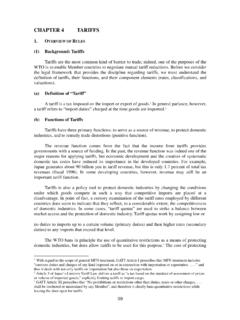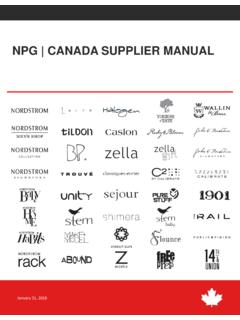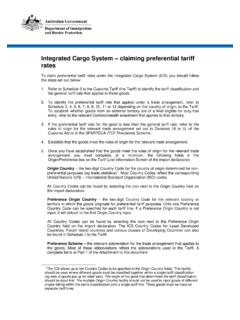Transcription of THE AUSTRALIAN PREFERENTIAL TARIFF REGIME
1 Organisation for Economic Co-operation and Development 2006 Organisation de Coop ration et de D veloppement Economiques OECD Trade Policy Working Paper No. 33 THE AUSTRALIAN PREFERENTIAL TARIFF REGIME By Douglas Lippoldt 2 ABSTRACT The purpose of this paper is to consider the PREFERENTIAL trade arrangements available to developing countries exporting into the AUSTRALIAN market. The paper opens with an overview of these arrangements, followed by a detailed statistical review. It then moves to examine several topics of particular interest in the discussion of AUSTRALIAN preferences. A simulation of the welfare impacts of preference erosion is then presented, followed by some brief concluding remarks. Compared to the Quad countries, Australia is a relatively small market for developing countries. At the same time, it is a relatively open market and some developing countries have come to rely on it as a destination for exports.
2 Given the structure of exports from developing countries, MFN access is often available at duty-free or low-duty rates and provides an attractive channel for entry. Concessional and PREFERENTIAL schemes provide important additional channels for developing countries exporting some goods that are subject to constraining MFN tariffs . Most developing countries have not come to rely on the AUSTRALIAN preferences for a large share of their trade. However, a few smaller countries -- particularly some with geographic proximity to Australia -- have come to rely on the AUSTRALIAN PREFERENTIAL REGIME for fairly significant shares of their exports. This reliance is associated with a degree of sector-specific concentration in the utilisation of preferences. Keywords: tariffs , nonreciprocal preferences, preference erosion, developing countries. ACKNOWLEDGEMENTS This paper was drafted by Douglas Lippoldt, a senior trade policy analyst in the OECD Trade Directorate (e-mail: He gratefully acknowledges the essential contributions of Karinne Logez (statistical assistance) and Caroline Mirkovic (research assistance) to the completion of this paper.)
3 The paper builds on analysis presented originally in Lippoldt and Kowalski (2005). The assistance of the AUSTRALIAN Bureau of Statistics in providing the underlying trade data and associated technical explanations was greatly appreciated and made this paper possible. An earlier version was presented at the Joint World Bank-WTO-OECD International Symposium on Preference Erosion: Impacts and Policy Responses , Geneva, 13-14 June 2005; this version was completed in September 2005. The study considers Australia s PREFERENTIAL trade according to a standardised framework developed for the Geneva symposium. The paper was prepared under the auspices of the OECD Trade Directorate project on preference erosion, however, the analysis and opinions expressed are those of the author and do not necessarily represent the views of the OECD or its Member countries. Copyright: OECD 2006.
4 Applications for permission to reproduce or translate all, or part of, this material should be made to: Head of Publication Service, OECD, 2 rue Andr -Pascal, 75775 Paris Cedex 16, France. 3 THE AUSTRALIAN PREFERENTIAL TARIFF REGIME Introduction 1. In terms of import volumes, Australia is a much smaller player in world trade than the Quad countries (Canada, Japan, the European Union and the United States). Its monthly average imports of about USD billion amount to less than 2% of the total imports into the Quad plus Australia area (Chart 1).1 Nevertheless, Australia is a major market for some developing countries. Its PREFERENTIAL programmes are locally important, with a total of about USD 19 billion in PREFERENTIAL imports claimed during 2004. Consequently, the impacts of its PREFERENTIAL arrangements merit a closer examination. The purpose of this paper is to consider the PREFERENTIAL trade arrangements available to developing countries exporting into the AUSTRALIAN market.
5 The paper opens with an overview of these arrangements, followed by a detailed statistical review. It then moves to examine several topics of particular interest in the discussion of AUSTRALIAN preferences. A simulation of the welfare impacts of preference erosion is then presented, followed by some brief concluding remarks. Description of the OECD TARIFF preference database 2. In order to analyse AUSTRALIAN PREFERENTIAL trade with developing countries, the OECD Secretariat developed an internal database on PREFERENTIAL trade using data provided by the AUSTRALIAN Bureau of Statistics (ABS). The building blocks for the database consist of the bilateral import flows by HS-10 digit product, taking into account country of origin and TARIFF treatment claimed at the time of import (Annex 1). For each year, about 100,000 lines of data were included, with each line representing the aggregate annual imports of an HS-10 digit product from one developing country.
6 Aggregate data and sub-totals in the following analysis are calculated by summing up the individual trade flows. While the original source data provide at least some information on substantially all AUSTRALIAN imports from developing countries, the OECD analysis generally excludes products classified as confidential (HS-99).2 Table 1, discussed below, provides a comparison of the flows including and excluding these confidential imports. The exclusion of the confidential trade flows from the analysis was generally necessary due to the lack of complete information on their nature. In addition, the schedule of most-favoured-nation (MFN) TARIFF rates was not available to the OECD in a database-compatible format ( they were not available in an Excel-compatible electronic format at the HS-10 digit level for many lines). Hence, the MFN rates were inferred as being the maximum applied rate for each product.
7 3. The OECD database covers TARIFF lines for which there were imports from developing countries during the years 1996, 2002, 2003 and 2004. The selection of the years covered by the database was driven by its evolution over time in the context of the larger OECD trade preference erosion project, but nonetheless captures information on a period of notable change in the AUSTRALIAN PREFERENTIAL TARIFF schemes. The year 1996 marks the original implementation of the framework legislation for the current TARIFF REGIME . The year 2003 marks the implementation of expanded duty-free and quota-free access for the least developed countries as well as the entry into force of a free trade agreement (FTA) with Singapore, while 2002 and 2004 provide an impression of the situation before and after the latter developments. 4. At the HS-10 digit product level, the determination of the applied TARIFF rate is a relatively complicated affair in Australia.
8 In the ABS database, imports are classified by product line according to 1 Australia accounted for about 3% of imports from developing countries into the Quad plus Australia area. 2 The AUSTRALIAN authorities place restrictions on the release of statistics where the imports or exports of an individual or a business are identifiable and that individual or business has requested that the details relating to the movement of these goods be suppressed. For more details, see the following ABS release: 4their country of origin and status with respect to each of three classifications: preference ( which scheme was claimed), treatment ( special considerations such as type of duty concession, but the most common of which is no treatment code ), and nature ( normal, concessional, quota or government). Together these features affect the TARIFF rate that is applied. 5. Broadly, the MFN rates are defined as the general rates of duty that apply when no preference has been claimed.
9 These rates are associated with goods entering Australia under one of two specific preference codes (X or Z). Unfortunately, these rates are not always available in the database and must be inferred in order assess the importance of Therefore, the MFN rates were determined using two methods: inferred statutory and calculated. Under the inferred statutory approach, MFN rates were determined for each HS-10 digit product by scanning the import lines across all developing countries. The inferred statutory MFN rate for each product was the maximum statutory rate. Specific duties, being comparatively rare under the AUSTRALIAN preference REGIME , were not taken into account under this The calculated MFN rates were determined for each HS-10 digit product based on actual duties collected as a percentage of the customs value of the goods. Here again, the maximum duty rate across the various developing countries was taken to be the MFN rate.
10 Under this approach, the specific duties were taken into account. For the purposes of the present analysis, both approaches were employed on a comparative basis. 6. In order to test the bias that each of the two approaches might introduce, a comparison was made between the results for each approach and the general rates of duty with respect to the lines for which both rates were available on an ad valorem basis. For the available TARIFF lines, the inferred statutory approach yielded an upward bias in the MFN rates of less than one-quarter of one percentage point in any year. The calculated MFN approach yielded an upward bias of less than one percentage point in any year. Each of the derived MFN approaches offers much greater product coverage than would otherwise be available from the database. The inferred statutory MFN approach yields estimates quite close to the actual MFN rates for those lines with ad valorem tariffs .













